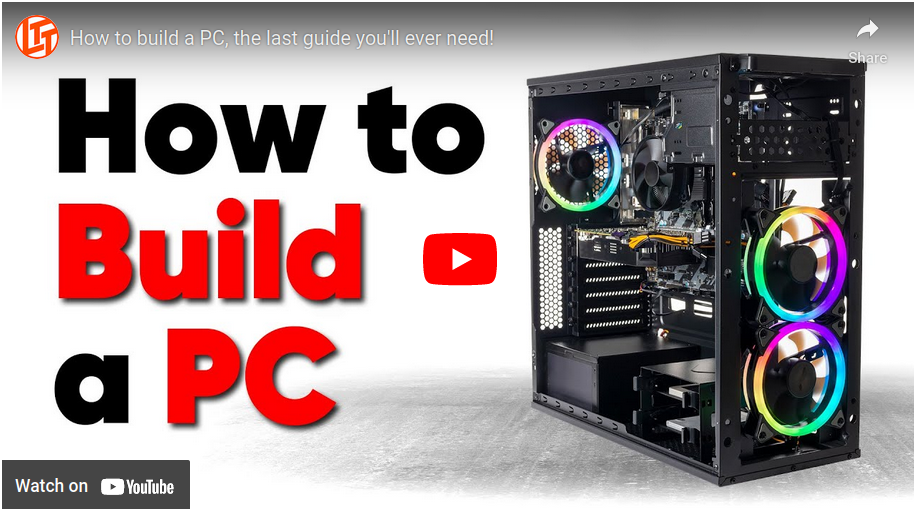Building Your Own

I realize so much of my advice is geared towards building an home server, without actually telling you how to do that. problem solved.
the best way to learn to do this is to watch youtube videos on it. so here one is:
Brought to you by LinusTechTips
this above videos is wayyyy more comprehensive than just pc assembly, so i linked it starting at the part when he actually is putting things together, but feel free to rewind and review the sections on part selection.
now, in the event you dont even have parts yet, the below sections will tell u how to shop for compatible parts to put together.
CPU/Motherboard
this is where i usually start. lets assume you want to use your server for media at some point. that means you probably need to transcode, which means unless you are buying a GPU, you are going to want an Intel CPU. what you should be looking for is intel cpu’s that are 10th gen and above. also, you dont need anything more powerful than an i3 or i5. you also dont want any cpus with an ‘F’ in their name, which means they dont have a built in GPU. we can probably avoid any ‘K’ chips as well, which are built for overclocking and gaming. they will work just fine in your build, but will probably be more expensive. that would mean these are what you are looking for:
| Part # | Socket | Launch Date | Motherboard Chipset |
| i5-10600 i5-10600T | LGA 1200 | Q2 2020 | B460, Z490, B560, Z590 |
| i5-10505 | LGA 1200 | Q1 2021 | B460, Z490, B560, Z590 |
| i5-10500 i5-10500E i5-10500T i5-10500TE i5-10400 i5-10400T i3-10320 i3-10300 i3-10300T i3-10105 i3-10100 i3-10100E i3-10100T i3-10100TE | LGA 1200 | Q2 2020 | B460, Z490, B560, Z590 |
| 11600 11600T 11500 11500T 11400 11400T | LGA 1200 | Q1 2021 | Z490*, B560, Z590 |
| 12600 12600T 12500 12500T 12400 12400T 12300T 12100 12100T G7400T G6900T | LGA 1700 | Q1 2022 | B660, B760, Z690, Z790 |
| 13600 13600T 13500 13500T 13400 13400T 13100T | LGA 1700 | Q1 2023 | B660*, B760, Z690*, Z790 |
* if you can, avoid these chipsets for this gen of intel cpus, since they may require a BIOS update to run properly
when purchasing a mobo to go with your cpu, the chipset has to match. u can buy any motherboard from any vendor with any specs, but the chipset has to be one of the ones listed above for your cpu. try to go for a full size ATX mobo if you can for easy expansion later.
Heatsink
all of these CPUs need cooling. some will come with cooling, some won’t. the idea is a heatsink is built for a certain socket. if you have an LGA 1200 socket, look for an LGA 1200 cooler. dont mix and match. Even though some CPU cooler manufacturers are providing adapter kits (usually in the form of different screws) to go with existing LGA115x retention brackets, there have been reports of the CPU bending or bowing due to uneven mounting pressure from the LGA 1700 integrated loading mechanism (ILM). This leads to the CPU having reduced contact with the cooler plate, which in turn leads to increased temperatures.
Memory
these days, memory is much easier to buy. for any of the above motherboard/cpu combos, you are looking for 288 pin DDR4 memory, non-ECC (or unregistered). however, some of the new chipsets support DDR5 memory (B760, Z690, Z790) so be sure to google your mobo to check before buying. in the event you want to be extra sure about compatibility, go to your motherboard’s Qualified Vendor List (QVL). here is a secret about mobos: the manual they come with is amazing. its probably all you need to build a computer with almost no other help.
in said manual, there is a QVL, which is a list of memory modules tested with that mobo that are guaranteed to work. an easy way to narrow your search for memory modules is to buy off of the QVL. to see the manual for your mobo, go to the manufacturers website, find the support section, and see if they have a digital QVL list or just download the PDF manual for your model mobo.